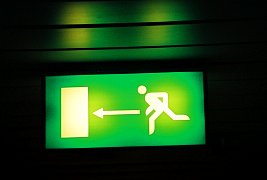
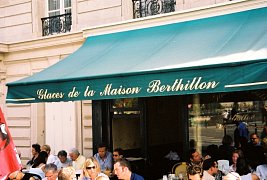 Here, just for fun, is the green 'running man' sign that everywhere points to your
closest avenue of escape. This is Margaret and my last day in Paris. We are going
to walk behind past Notre Dame Cathedral to the Isle St. Louis. This is the one
part of Paris where the streets are still narrow like they were during the
middle ages. They have excellant ice cream in this section of Paris - here is
where we got our cones.
Here, just for fun, is the green 'running man' sign that everywhere points to your
closest avenue of escape. This is Margaret and my last day in Paris. We are going
to walk behind past Notre Dame Cathedral to the Isle St. Louis. This is the one
part of Paris where the streets are still narrow like they were during the
middle ages. They have excellant ice cream in this section of Paris - here is
where we got our cones.
|
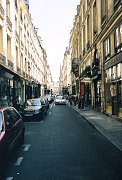
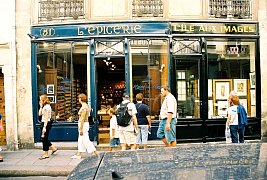 These narrow streets are so very different that the wide avenues one associates
with modern Paris. I liked this section a lot.
These narrow streets are so very different that the wide avenues one associates
with modern Paris. I liked this section a lot.
|
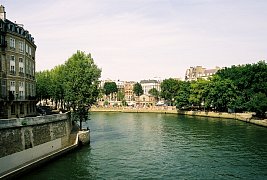 Now we are crossing a bridge over the Seine to start our walk to
la Place de la Bastille which contains
the Colonne de Juillet
and is the former site of the Bastille fortress and prision.
Now we are crossing a bridge over the Seine to start our walk to
la Place de la Bastille which contains
the Colonne de Juillet
and is the former site of the Bastille fortress and prision.
|
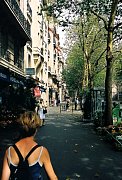

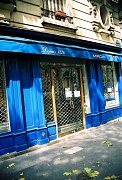
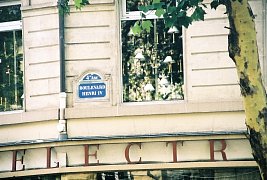
|
|
Here are some scenes as we walk along the wide boulevard. Many stores close
around noon and stay closed for a couple of hours. The French like long lunches
I guess.
|

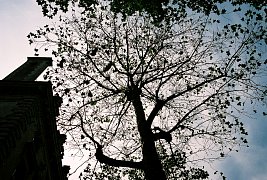
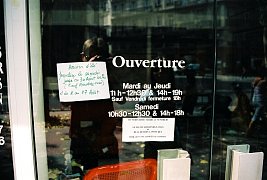
|
|
There are obscure reasons why I take certain pictures. Thee leaves
(above) show how dry the summer season is - leaves are prematurely dropping
off the trees. The final picture is a hand made card explaining
the hours they are open.
|
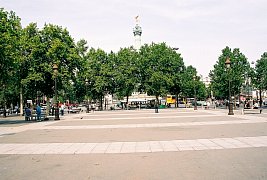 The Colonne de Juillet, which celebrates France's Independence Day, dominates la Place de
la Bastille. La Place de la Bastille stands in proximity to where the
Bastille fortress stood. Built in 1369, its eight huge towers once loomed over Paris.
It was used as a prison in the
17th century (Voltaire and the Marquis de Sade were among its most famous inmates).
Detention was quite comfortable for those
who had the financial possibilities and relations and the prisoner could
give parties, and organize suppers.
By the time of the French Revolution the Bastille fortress was used less and less.
It was stormed by the Paris Mob on July 14,1789 at the
start of the French Revolution. When the
people stormed the
bastion there were only seven prisoners - four
money counterfeiters and the Count of
Solages, who was imprisoned under the accusation of incest.
The governor and the whole garrison were murdered and the mob
looted all the weapons. Louis XVI was unimpressed and recorded in his diary: "Today,
nothing".
The Colonne de Juillet, which celebrates France's Independence Day, dominates la Place de
la Bastille. La Place de la Bastille stands in proximity to where the
Bastille fortress stood. Built in 1369, its eight huge towers once loomed over Paris.
It was used as a prison in the
17th century (Voltaire and the Marquis de Sade were among its most famous inmates).
Detention was quite comfortable for those
who had the financial possibilities and relations and the prisoner could
give parties, and organize suppers.
By the time of the French Revolution the Bastille fortress was used less and less.
It was stormed by the Paris Mob on July 14,1789 at the
start of the French Revolution. When the
people stormed the
bastion there were only seven prisoners - four
money counterfeiters and the Count of
Solages, who was imprisoned under the accusation of incest.
The governor and the whole garrison were murdered and the mob
looted all the weapons. Louis XVI was unimpressed and recorded in his diary: "Today,
nothing".
|
|
The Bastille was demolished soon after the French Revolution.
Today, on the spot where the prison used to stay, special pavements show you the
limits of the fundaments (between 5, place de la Bastille and 49, boulevard Henri IV).
In the subway station beneath the square, stones
from the Bastille's foundation can still be seen.
Following the dismantling of the Bastille, an
enterprising workman, named Palloy, made sculptures of the
prison from the rubble, and sold them to local councils, who
were denounced as anti-republican if they refused the high price demanded. The rest
was used to finish the Pont de la Concorde.
The original remains of the Bastille prison are a few rocks in the square Galli, in
Sully-Morland, some stones on the metro line Pantin-Italie (direction Pantin), a
Bastille-souvenir carved in original Bastille stone displayed at the musee Carnavalet
and the ancient chime of the Bastille inside the "Hippopotamus" restaurant on the
place de la Bastille.
|
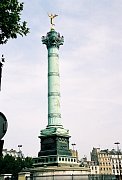 Colonne de Juillet--The July Column doesn't commemorate the Revolution but honors the
victims of the July Revolution of 1830, which put
Louis-Philippe on the throne after the heady but wrenching
victories and defeats of
Napoleon Bonaparte. The winged God of Liberty, whose
forehead bears an emerging star, crowns the tower.
When the actual column of the Bastille was erected it was alternately called the Colonne de
Juillet, a monument to the revolution of 1830 .
The column is engraved in gold with the names of
Parisians who died during the revolution. The gold-covered statue
at the top is called the Génie de la Révolution (the Genesis of the
Revolution, approximately)
The corpses of
the victims were buried under the column.
Today, besides of still being a symbol for democracy and the
starting point of a lot of protest demonstrations heading for the
place de la Republique,
Colonne de Juillet--The July Column doesn't commemorate the Revolution but honors the
victims of the July Revolution of 1830, which put
Louis-Philippe on the throne after the heady but wrenching
victories and defeats of
Napoleon Bonaparte. The winged God of Liberty, whose
forehead bears an emerging star, crowns the tower.
When the actual column of the Bastille was erected it was alternately called the Colonne de
Juillet, a monument to the revolution of 1830 .
The column is engraved in gold with the names of
Parisians who died during the revolution. The gold-covered statue
at the top is called the Génie de la Révolution (the Genesis of the
Revolution, approximately)
The corpses of
the victims were buried under the column.
Today, besides of still being a symbol for democracy and the
starting point of a lot of protest demonstrations heading for the
place de la Republique,
|
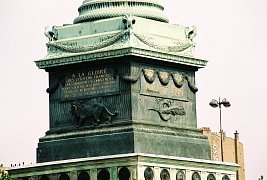
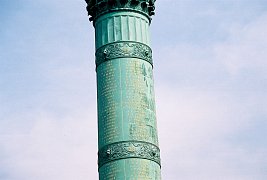
|
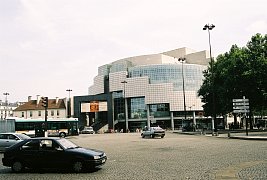 The area is dominated by another
manifestation of the building rage of statesmen: since 1989 the new Opéra de Paris or
Opéra-Bastille has opened its doors (Monday-Saturday 10am-6.30pm). This gigantic
glass cage has seats for a 2,700 strong audience. The opera has totally transformed
the character of the district. But it must be said that the opening of the Opera Bastille
started definitively the renewal of the area, as well as his sociological overturning.
The area is dominated by another
manifestation of the building rage of statesmen: since 1989 the new Opéra de Paris or
Opéra-Bastille has opened its doors (Monday-Saturday 10am-6.30pm). This gigantic
glass cage has seats for a 2,700 strong audience. The opera has totally transformed
the character of the district. But it must be said that the opening of the Opera Bastille
started definitively the renewal of the area, as well as his sociological overturning.
|
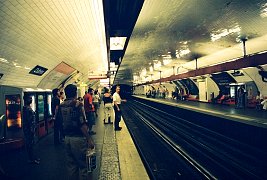
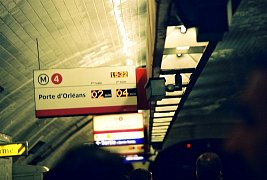 We returned to Place St. Michel via the Paris subway.
We returned to Place St. Michel via the Paris subway.
|


















